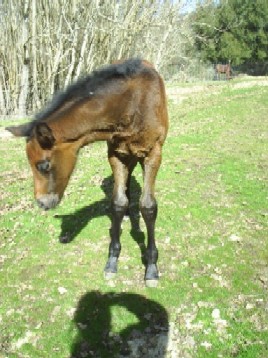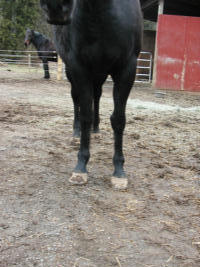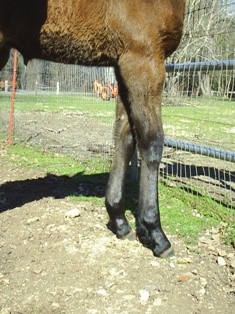Site Menu:
| This is an archived Horseadvice.com Discussion. The parent article and menus are available on the navigation menu below: |
| HorseAdvice.com » Diseases of Horses » Lameness » Joint, Bone, Ligament Diseases » Angular Limb Deformities in Foals » |
| Discussion on Limb deformity | |
| Author | Message |
| Member: ttownzen |
Posted on Thursday, Mar 6, 2008 - 6:05 pm: My filly was born with a mild to moderate angular deformity in her right front, with the left being just mildly deformed. There is no swelling and no heat, but when the legs get fatigued she seems to swing them a bit when walking. In my rural location, no veterinarians make house calls, and a trip to the nearest equine veterinarian is 70 miles one way over a very windy road. UC Davis is 300 miles away and the nearest/best location for the stripping procedure. Here is a picture of her at 3 weeks, and she seems to be getting better. I kept them in the stall for the first 3 weeks, and this last week I have been letting them out anywhere from 45 minutes to 2 hours depending on how much they run around and how fatigued the legs appear.At this point, do you think I should risk additional injury by trailering her for diagnosis/treatment, or give the leg some additional time? Is it better to minimize exercise or does she need the exercise to strengthen the ligament? 
|
| Member: dres |
Posted on Thursday, Mar 6, 2008 - 6:23 pm: how about a side view too, taken with you lower to the ground..cute foal.. On the first day God created horses, on the second day he painted them with spots.. |
| Moderator: DrO |
Posted on Thursday, Mar 6, 2008 - 8:11 pm: Hello Teri,There would be no extra problem with trailering the foal but at 4 weeks of age you may have some time depending on the actual problem, see the article for possible causes. Without radiographs the main questions are:
In general legs with that amount of deviation from periosteal unevenness would be allowed free exercise but not knowing the cause accurate recommendations are impossible. What is happening that makes you think the legs are getting tired? What keeps you from trailering to the closer veterinarian? He can take the radiographs almost as well as USC and (before my back prevented me from from working from kneeling position for more than a few minutes) did the periosteum release surgery described in the article in the field, it is not technically difficult. DrO |
| Member: ttownzen |
Posted on Thursday, Mar 6, 2008 - 8:41 pm: Ann, I'll try to get another view tonight or tomorrow.Dr. O., I've read the articles, and I could be making it crooked by staring at it!  There are no swellings. As a newborn, I thought I could see some sort of stride deficit at the walk with the right front but the trot seemed fine and completely weight bearing. Yes, they are improving, but with a wide base stance still noticeable. The reason I think the legs get tired is because up until yesterday if I left her out more than an hour, both front knees remained slightly bent (over in the knee)and would shake. After a nap, she would get back up and be fine. She was out for over 3 hours last evening, and seemed fine when I put her in. Thus my post, perhaps I'm doing more harm than good by limiting her exercise. The hazards of trailering a baby unnecessarily with such poor roads is what held me back as even the nearest equine vet is 3 hours round trip at best if no one tries to run you off the road for going slow. One of the many joys of living in the middle of nowhere. 
|
| Member: pbauer |
Posted on Thursday, Mar 6, 2008 - 9:12 pm: Dear Terri,I was reading an article about this problem, and it stated: Most foals with angular limb deformities self-correct. I'll be praying for your baby! My Best, Tonya 
|
| Member: ekaufman |
Posted on Thursday, Mar 6, 2008 - 10:10 pm: Hi Terri,I have a mare who folds her foals like some people fold a gum wrapper. They come out like origami babies-- contracted, lax, and with major ALD. They all (so far) end up with good legs eventually. One thing I believe to be very important is to keep trimming the feet to ensure that the hoof lands flat, no matter how the leg gets there. ALD foals tend to wear their feet oddly, which causes the legs to land in a way that makes the leg worse. Dr. Mindy Story at Littleton Large saw one of my very strange babies, and said "if the foot lands flat, whatever the leg can do to straighten, it will do on its own. The rest is surgical." Mine have always straightened out with care and lots of small trim jobs. Good luck with your cute baby! To my eye, it doesn't look bad, but I've had foal legs that stick straight out to the side, so am no judge.... |
| Member: ttownzen |
Posted on Thursday, Mar 6, 2008 - 10:55 pm: Thanks for the prayers Tonya, I read that as well. I was hoping that perhaps I was just overreacting like I did with her impaction, her diarrhea, and her seemingly larger than normal (but dry) umbilical. I just don’t want to allow for a self correction too long and lose the window of opportunity for a simple corrective procedure. Tonight she seems a little more over in the knee so I’ll call and make an appt for radiograph tomorrow. Since it appears that warmbloods are highly susceptible to OCD, an x-ray certainly won’t hurt. A friend told me today that we have a roaming veterinarian coming to this area once a month and he might have portable x-ray equipment. I will check that out as well. If I don’t have to haul her, I’ll be thrilled. We do have a local small animal vet, who can probably x-ray her who is only 15 miles out. He does work on all animals as a courtesy, but his specialty is birds. With something like this I thought it best to go to a veterinarian who is primarily equine. Decisions, decisions. It’s all worth it when I kiss her soft little muzzle.Elizabeth, have your foals corrected without surgery, and how long before you noticed an improvement? How soon do you start trimming. My horses have a hard time going barefoot because of the footing in my fields. Rocks, rocks and more rocks. Feet wear down quickly without a shoe. My shoer thinks I'm the most devoted rider he has due to the wear of the shoes. In reality, it's the turnout. My shoer is down the hill as well, so she'll be learning to haul soon one way or another. |
| Member: ekaufman |
Posted on Thursday, Mar 6, 2008 - 11:16 pm: Hello Terri,Yes, so far mine have all corrected without surgery. I did use oxy-tet on this year's baby, because he was so contracted in front that we decided he could use the help. Every foal is a bit different. Trimming wasn't a good word choice-- I use a rasp to shape the foot slightly. Specifically, I seem to end up bringing back the toe and correcting the lateral balance. I start rasping as soon as I notice the hoof is wearing unevenly. I do a little bit as often as I can, just to keep that hoof landing flat. My farrier keeps an eye on things to make sure I'm not wandering into the weeds. I think this year the foal was a week old when I started. It seems at least with my foals that you get maybe 75% improvement in a month or two, and the rest takes longer. But there are important timeframes for cases that need surgery, so I pull radiographs when I get edgy. So far, so good. Remember that if your bird doctor can take a good x-ray, others can interpret it for you. |
| Moderator: DrO |
Posted on Friday, Mar 7, 2008 - 7:42 am: The article already referenced discusses the amount of deviation that has a good chance of self correcting and what the window of opportunity is. But all this is prefercenced on knowing the cause, the prognosis is different for different causes of valgus carpal deviation. It is a good sign that you are seeing correction with no other signs of stress in the knees.The problem of tiredness you are describing is a different problem: mild flexor contracture that worsens with exercise. For more on this see, Diseases of Horses » Lameness » Muscle & Tendon Diseases » Tendon Laxity and Contracture. DrO |
| Member: ttownzen |
Posted on Friday, Mar 7, 2008 - 12:15 pm: Boy, the more I read, the more paranoid I get. I have a call in to the vet for an appt. I didn't see anything written that references whether or not angular deformity (is it the same as periosteal unevenness)is accompanied by mild flexor contracture. Is it common, or would that be more rare? |
| Member: jerre |
Posted on Friday, Mar 7, 2008 - 3:17 pm: Terri, I had PT done on my filly at 4 months. Here are her legs at 5 years. The right is still turned, but throughout the whole leg. She has very nice movement. If I remember, the surgery and associated costs was about $1200 (we did both legs). I have been trying to load before pix, but am very frustrated with my dial up! Here is my original thread for before pix. I will try to post an after pix there also. https://www.horseadvice.com/horse/messages/4/16910.html Jerre P.S. That's not a deformed hoof -- just too much mud. And the trimmer is coming today, she's done every 5 weeks. |
| Member: ttownzen |
Posted on Friday, Mar 7, 2008 - 11:53 pm: Thanks for the light at the end Jerre, she looks really good now. Was she buckled in the knee as well, or only the angular? |
| Member: jerre |
Posted on Saturday, Mar 8, 2008 - 12:43 am: Hi Terri, did you look at the link for her foal pix?Her knees were straight. In fact, she was very upright, especially in the pasterns. But, she has great angles now. And,she looks better, but her right leg is still crooked, especially if she's standing goofy. I can square her up pretty nice though. She's sound and has excellent self carriage. My vet said he'd pass her on a pre-purchase no problem -- but then, he did the surgery, so he has a sort of investment, I suppose. |
| Moderator: DrO |
Posted on Saturday, Mar 8, 2008 - 9:20 am: Terri what is it you read that makes you paranoid? It should be the demonstrable problems the foal has that give you concern. The front view of your foal is not that bad and the article gives recommendations for dealing with foals with flexor deformities, the description of which you give seems mild also. That said internet advice is no substitute for a professional examination when you are uncertain what you are dealing with.DrO |
| Member: ttownzen |
Posted on Saturday, Mar 8, 2008 - 3:27 pm: I'm thinking the paranoid is genetics... on my part that is. I have left a message with the roaming veterinarian regarding getting some x-rays. If that doesn't work out then I'll take her down for hill for a professional diagnosis. Here's one from today after running around for about 2 hours. When she walks on the leg it straightens out almost completely. When she is just standing she is like this and sometimes a little worse. I think this is better than 3 weeks ago
|
| Moderator: DrO |
Posted on Sunday, Mar 9, 2008 - 10:18 am: Genetics perhaps but usually in combination with nutrition, is the mare mikling heavy and the foal growing quickly?As long as improving great, but if it stops consider the nutritional advice in the article. DrO |
| Member: ttownzen |
Posted on Sunday, Mar 9, 2008 - 10:59 am: I did read the nutritional advice, and yes heavy milk, fast growing foal. I have the mare on good quality grass hay, all she can eat, and have been free feeding her alfalfa meal to keep her weight up. (previous owners said baby would drag her down fast and she was a bag of bones when I got her). Maybe momma will just have to lose a few. Will see what the vet says. Yesterday was her first full day out. This morning she is just exhausted but legs look good. Nice weather today, so out she'll go. No news yet from the roaming vet. Looks like she and momma may get to go for a ride. |
| New Member: lgill |
Posted on Wednesday, May 27, 2009 - 7:51 am: You can always use Dynasplint Systems to correct angular & flexural limb deformities in your foals or older horses.https://www.dynasplint.com/division/veterinary.php Dynasplint Systems is used to correct angular and flexural limb deformities in small and large animal. In a very gentle, non-invasive way, the bilateral tensioning system within each Dynasplint System is able to correct the following problems: a) carpal contractures; b) carpal hyperextensions; c) fetlock contractures; d) fetlock laxities; c) deep digital flexor tendon contractures; d) upright pasterns; e) valgus/varus carpals, tarsals, & fetlocks; f) any loss of range of motion due to surgery, lacerations, or congenital problems; g) as well as many other lower limb issues. |
| New Member: equigran |
Posted on Wednesday, Nov 15, 2017 - 7:44 pm: We have a new week old colt foal with a slightly bowed nearside front leg and walking on the outside of his hoof. He is slightly toed in. Should he be locked up?The farrier is coming this afternoon to trim his hoofs. |
| Moderator: DrO |
Posted on Thursday, Nov 16, 2017 - 9:09 am: Welcome to the boards Rosemary,The answer to your question will depend on the actual structures causing the deformity and the degree to which they are affected. The article associated with this section explains these particulars and will help you understand what goes into this decision when you discuss this with your veterinarian. It is important to realize that each discussion belongs to the originator of the discussion and so when you are asking a new question you should start your own discussion, you will receive more and faster responses that way. You will find the New Discussion button at the bottom of the article referenced above. DrO |
is The Horseman's Advisor
Helping Thousands of Equestrians, Farriers, and Veterinarians Every Day
All rights reserved, © 1997 -
